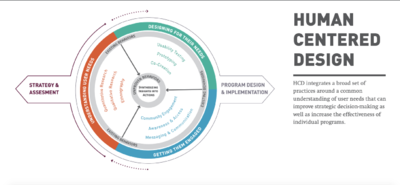Difference between revisions of "Human-Centered Design (HCD)"
| Line 1: | Line 1: | ||
| − | '''Human-centered design''' is a creative approach to [[Problem Solving|problem solving]]. It’s a process that starts with the people you’re designing for and ends with new solutions that are tailor made to suit their needs. Human-centered design is all about building a deep empathy with the people you’re designing for; generating tons of ideas; building a bunch of prototypes; sharing what you’ve made with the people you’re designing for; and eventually putting your innovative new solution out in the world. | + | '''Human-centered design''' is a creative approach to [[Problem Solving|problem solving]]. It’s a process that starts with the people you’re designing for and ends with new solutions that are tailor made to suit their needs. Human-centered design is all about building a deep empathy with the people you’re designing for; generating tons of ideas; building a bunch of prototypes; sharing what you’ve made with the people you’re designing for; and eventually putting your innovative new solution out in the world.<ref>Definition - What Does Human Centered Design Mean? [https://designthinking.ideo.com/faq/whats-the-difference-between-human-centered-design-and-design-thinking Ideo]</ref> |
| − | [[File:Human Centered Design.png|400px|Human Centered Design]] | + | [[File:Human Centered Design.png|400px|Human Centered Design]]<br /> |
source: [https://dalberg.com/what-is-human-centered-design/ Dalberg] | source: [https://dalberg.com/what-is-human-centered-design/ Dalberg] | ||
| + | |||
| + | |||
| + | '''Origin of Human-Centered Design<ref>Origin of Human-Centered Design [https://en.wikipedia.org/wiki/Human-centered_design Wikipedia]</ref>'''<br /> | ||
| + | Human-centered design has its origins at the intersection of numerous fields including engineering, psychology, anthropology and the arts. As an approach to creative problem-solving in technical and business fields its origins are often traced to the founding of the Stanford University design program in 1958 by Professor John E. Arnold who first proposed the idea that engineering design should be human-centered. This work coincided with the rise of creativity techniques and the subsequent design methods movement in the 1960s. Since then, as creative design processes and methods have been increasingly popularized for business purposes, human-centered design is increasingly referred to simply as "design thinking". | ||
| + | |||
| + | In Architect or Bee?, Mike Cooley coined the term "human-centered systems" in the context of the transition in his profession from traditional drafting at a drawing board to computer-aided design. Human-centered systems,[4] as used in economics, computing and design, aim to preserve or enhance human skills, in both manual and office work, in environments in which technology tends to undermine the skills that people use in their work. | ||
| + | |||
| + | In the 2008 paper "On Human-Machine Symbiosis" Cooley asserts "Human centeredness asserts firstly, that we must always put people before machines, however complex or elegant that machine might be, and, secondly, it marvels and delights at the ability and ingenuity of human beings. The Human Centered Systems movement looks sensitively at these forms of science and technology which meet our cultural, historical and societal requirements, and seeks to develop more appropriate forms of technology to meet our long-term aspirations. In the Human Centered System, there exists a symbiotic relation between the human and the machine, in which the human being would handle the qualitative subjective judgements and the machine the quantitative elements. It involves a radical redesign of the interface technologies and at a philosophical level, the objective is to provide tools (in the Heidegger sense) which would support human skill and ingenuity rather than machines which would objectivize that knowledge". | ||
Revision as of 23:33, 27 October 2021
Human-centered design is a creative approach to problem solving. It’s a process that starts with the people you’re designing for and ends with new solutions that are tailor made to suit their needs. Human-centered design is all about building a deep empathy with the people you’re designing for; generating tons of ideas; building a bunch of prototypes; sharing what you’ve made with the people you’re designing for; and eventually putting your innovative new solution out in the world.[1]

source: Dalberg
Origin of Human-Centered Design[2]
Human-centered design has its origins at the intersection of numerous fields including engineering, psychology, anthropology and the arts. As an approach to creative problem-solving in technical and business fields its origins are often traced to the founding of the Stanford University design program in 1958 by Professor John E. Arnold who first proposed the idea that engineering design should be human-centered. This work coincided with the rise of creativity techniques and the subsequent design methods movement in the 1960s. Since then, as creative design processes and methods have been increasingly popularized for business purposes, human-centered design is increasingly referred to simply as "design thinking".
In Architect or Bee?, Mike Cooley coined the term "human-centered systems" in the context of the transition in his profession from traditional drafting at a drawing board to computer-aided design. Human-centered systems,[4] as used in economics, computing and design, aim to preserve or enhance human skills, in both manual and office work, in environments in which technology tends to undermine the skills that people use in their work.
In the 2008 paper "On Human-Machine Symbiosis" Cooley asserts "Human centeredness asserts firstly, that we must always put people before machines, however complex or elegant that machine might be, and, secondly, it marvels and delights at the ability and ingenuity of human beings. The Human Centered Systems movement looks sensitively at these forms of science and technology which meet our cultural, historical and societal requirements, and seeks to develop more appropriate forms of technology to meet our long-term aspirations. In the Human Centered System, there exists a symbiotic relation between the human and the machine, in which the human being would handle the qualitative subjective judgements and the machine the quantitative elements. It involves a radical redesign of the interface technologies and at a philosophical level, the objective is to provide tools (in the Heidegger sense) which would support human skill and ingenuity rather than machines which would objectivize that knowledge".
